“Buzz Brands” is one of the four Wine Lister Indicators developed to help our users identify wines for different scenarios. A Buzz Brand is a wine with strong distribution in the world’s top restaurants, enjoying high levels of online search frequency or demonstrating a recent growth in popularity, and identified by the fine wine trade as trending or especially prestigious. As such, you wouldn’t expect them to come cheap, and the five most expensive dry whites definitely don’t, costing around £2,000 on average.
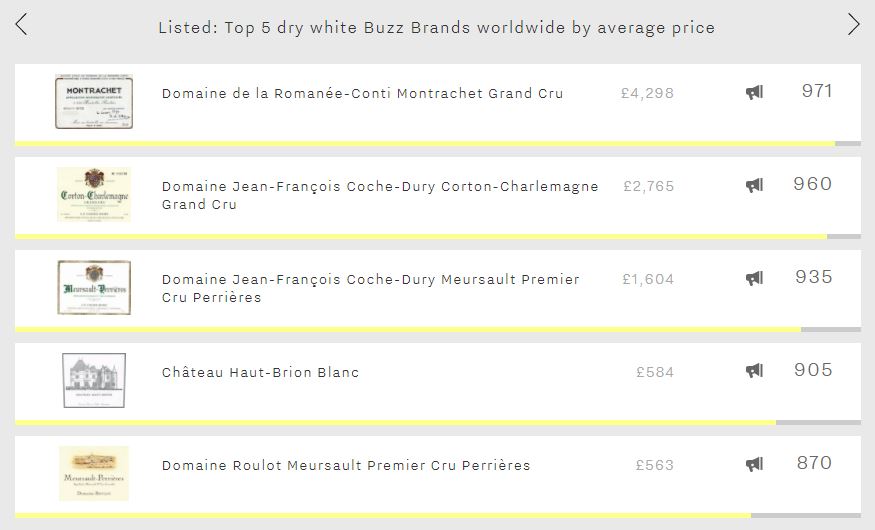
Perhaps unsurprisingly given the miniscule production of its top wines, Burgundy fills four of the five spots (and two of these are from Coche-Dury). DRC Montrachet is the world’s second-most expensive dry white – behind Leflaive’s Montrachet which fails to achieve Buzz Brand status. It achieves the best Quality score of this week’s top five (976), just pipping Coche-Dury’s Corton-Charlemagne to the post (971). It also enjoys the highest Brand score of the group – or any dry white for that matter (960) – the result of appearing in considerably more of the word’s top restaurants than Coche-Dury’s Corton-Charlemagne, which comes second in that criterion (26% vs 19%), and also being nearly 50% more popular than any of the rest of the five.
Whilst Coche-Dury’s Corton-Charlemagne has to settle for second place in the Quality and Brand categories, it not only manages the group’s top Economics score (991), but also the highest of any dry white on Wine Lister. This is thanks to formidable price growth. It has recorded a three-year compound annual growth rate (CAGR) of 25%, and has added 14% to its price over the last six months alone.
It is to be expected that wines from two of Burgundy’s most hallowed grand cru vineyards command the group’s highest prices, but it might come as more of a surprise that two Meursaults from the premier cru Perrières vineyard feature. With over £1,000 separating the considerably more expensive offering from Coche-Dury and Roulot’s expression, it becomes clear that Brand score is a significant driver of price at this rarefied end of the scale, particularly within Burgundy.
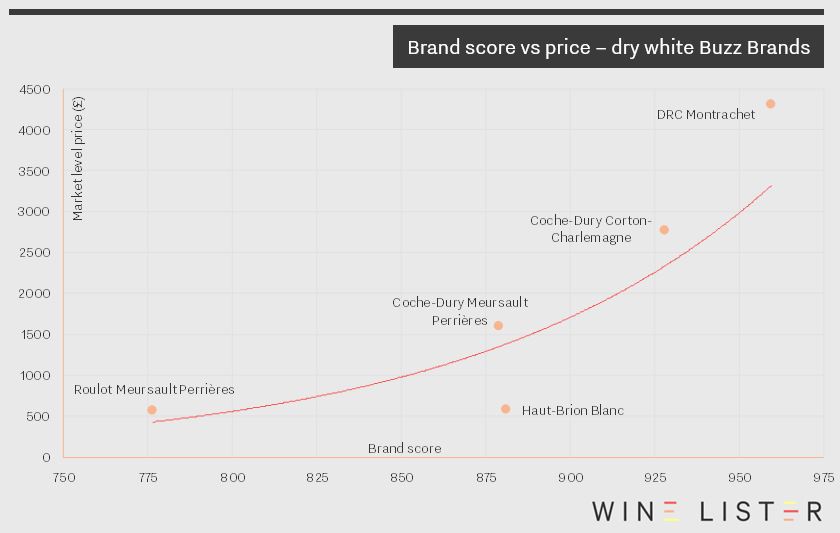
Proving that expensive Buzz Brands are not only to be found in Burgundy, Haut-Brion Blanc makes an appearance in the top five. Whilst it is the most liquid of the group – its top five traded vintages have traded 49% more bottles than any other wine in the five – it has experienced by far the lowest growth rates, with a three-year CAGR of 9% compared to the Burgundy quartet’s remarkable average of 22%.
Hidden Gems are one of four Wine Lister “Indicators”, segmenting wines that meet specific sets of criteria into groups. Hidden Gems are those wines rarely found in the top restaurants, and not often searched for online, but which either have high ratings from wine critics, or have been singled out as a hidden gem by Founding Members in Wine Lister surveys.
Last week, Wine Lister celebrated its second birthday with a special tasting of a selection of 27 “raw” hidden gems, identified by our Founding Members (c.50 key players from the international fine wine trade) when asked which wines they rated highly, but which they felt were underappreciated.
Founding Members’ Hidden Gems hail from a variety of regions, producers and vintages. Their average Wine Lister scores vary too, as shown on the histogram below, where the grey columns represent the total number of fine wines currently listed on Wine Lister which fall into each score bucket.
The full list of wines tasted is available here: Wine Lister Founding Members’ Hidden Gems
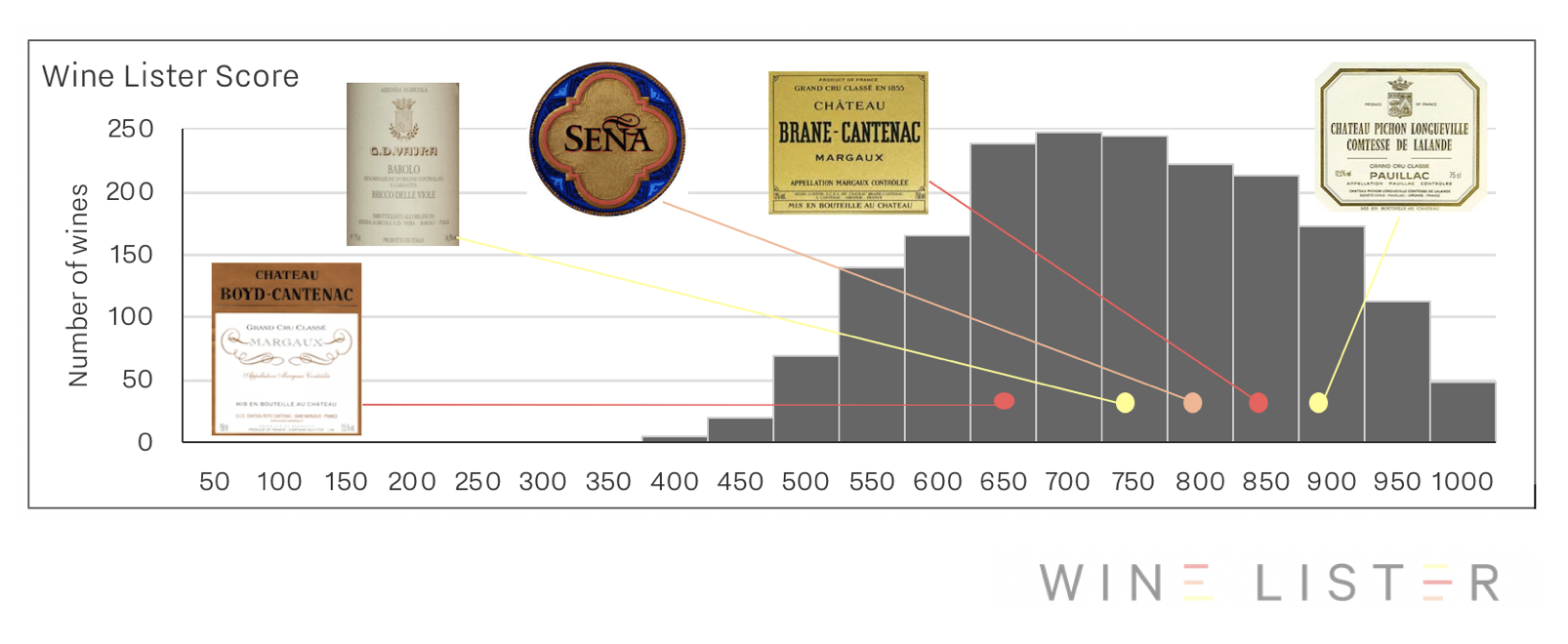
The Wine Lister team was joined by some of our trade Founding Members, data partners, and other supporters of Wine Lister. We encouraged tasters to share their comments by writing on the tasting table. All the wines were showing beautifully, and G.D. Vajra’s Barolo Bricco delle Viole 2009, tasted from magnum, won widespread praise from all the guests. It also holds the highest Quality score (927) of all wines in the room. One taster even went so far as to name it “the Lafite of Barolo”!
 From left to right: David Harvey, Arthur de Lencquesaing, Dan Jago, Charles Lea, Ella Lister, Jancis Robinson, Jan Konetzki, Adam Bruntlett, Katy Andersen, Grant Ashton, Sophie Mclean, Richard Harvey, Greg Sherwood, Aita Ighodaro, Joe Fattorini.
From left to right: David Harvey, Arthur de Lencquesaing, Dan Jago, Charles Lea, Ella Lister, Jancis Robinson, Jan Konetzki, Adam Bruntlett, Katy Andersen, Grant Ashton, Sophie Mclean, Richard Harvey, Greg Sherwood, Aita Ighodaro, Joe Fattorini.
Find out what else was said about the wines by following this link to more photos of the event.
Wines featured in the tasting: Louis Roederer Brut Premier, E. Guigal Condrieu La Doriane 2016, Casa Lapostolle Clos Apalta 2014, Seña 2010, Henschke Mount Edelstone Shiraz 2014, Isole e Olena Syrah Collezione Privata 2011, Tenuta San Guido Guidalberto 2016, Tenuta dell’Ornellaia Le Serre Nuove 2015, 2011, 2007, Produttori del Barbaresco Barbaresco 2014, G.D. Vajra Barolo Albe 2013, G.D. Vajra Barolo Bricco delle Viole 2009, Domaine Duroché Gevrey-Chambertin Les Jeunes Rois 2015, Domaine Duroché Chambertin Clos de Bèze Grand Cru 2015, Domaine Tempier Cuvée Cabassou 2007, Château La Gaffelière 2014, Le Marquis de Calon Ségur 2014, Château Haut-Bailly La Parde 2012, Château Les Carmes Haut-Brion 2014, Château Boyd-Cantenac 2013, Château d’Issan 2011, Château Branaire-Ducru 2012, Château Pédesclaux 2014, Château Pichon Longueville Comtesse de Lalande 2005, Château Brane-Cantenac 2005, Château Lafon Rochet 2010.
Yes, that question: “which are better, Old World or New World wines?” Traditionalists may argue that the latter lack the prestige and quality of their Old World counterparts. Those with a preference for the New World might see these wines as better value for money, free of the price tag accompanying wines from famously exclusive Old World vineyards.
Wine Lister has compared the top 50 wines by Quality score from Old World and New. The average Quality score of the top 50 wines is 983 in the Old World and 948 in the New. Though both Worlds sit comfortably in the “strongest” section of the Wine Lister 1000-point scale for Quality, the price gap tells a different story. The average price for a top 50 ranking Old World wine is £2,114 per bottle – seven times higher than the average New World equivalent (£297).
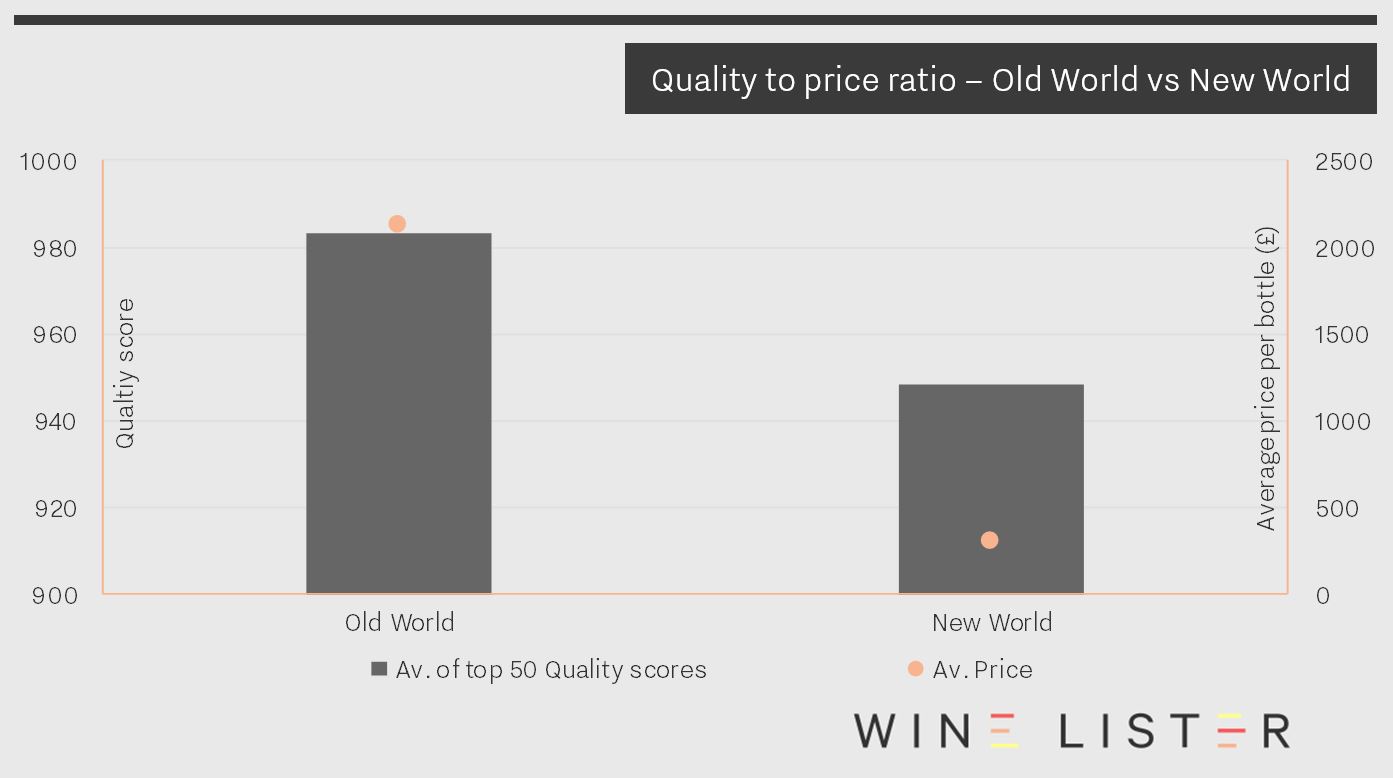
The wine with the highest Quality score on Wine Lister is Egon Müller’s Scharzhofberger Riesling TBA, which achieves a wine level Quality score of 995, having fallen just one point shy of the perfect 1,000 point score for the 2010 vintage. Riesling’s quality proliferates in the top 50, with 16 entries across Germany and Alsace. The high critics’ scores are balanced by exceptionally high prices, with an average price of £2,509 per bottle.
Though the Old World Quality top 50 is in fact white wine dominant, red Burgundy is well represented, with 13 entries and an average Quality score of 983 at £3,164 per bottle. Even excluding DRC La Romanée-Conti’s remarkable price (£11,722 per bottle), Burgundy’s remaining 12 finest reds command an average price of £2,450 per bottle.
Champagne wins the price vs quality race for the whites, with an average Quality score across its four entries of 981 at £348 per bottle. Even more impressive are the five Port entries, with an average Quality score of 982 at £244 per bottle.
In contrast to the diverse set of regions represented in the Old World top 50, the New World list is dominated by California (with 40 out of 50 wines hailing from the region). These wines achieve an average Quality score of 948 at £315 per bottle – not quite as good value as the Champagnes and Ports, but seemingly better value than their red Burgundian counterparts.
Though there are fewer entries from Australia (seven in total), the New World’s number one wine for quality comes from the Barossa Valley. Torbreck The Laird has a Quality score of 984 points and a price of £427 per bottle. When comparing this to an Old World wine of the same score, the price difference is evident. Domaine Leroy’s Romanée Saint Vivant benefits from the same Quality score, but is nearly five times more expensive, at £1,975 per bottle.
Wine Lister uses search frequency data from our partner, Wine-Searcher, to examine wines with increasing online popularity on a monthly basis. Wines with the highest search frequency numbers tend to be consistent, with the Bordeaux left bank premiers crus classés generally taking the top spots.
This month’s biggest search frequency gainers also rank as some of the most searched-for wines on Wine-Searcher. Dom Pérignon Vintage Brut is the third most popular wine with over 84,000 searches after Lafite and Mouton, closely followed by Petrus in fourth place. Armand Rousseau’s Chambertin and Moët & Chandon Grand Vintage appear in the top 50, while Azienda Agricola Falletto’s Barolo Rocche Falletto Riserva comes lower down at number 148 out of the circa 5,000 wines on Wine Lister, but its search frequency has recently increased by 15%.
Our last post on online search frequency revealed Wine Lister’s first ever perfect Brand score. Moving on from the Christmas period, Champagne brands still show marked increases in search frequency, but this time they do not stand alone at the top.
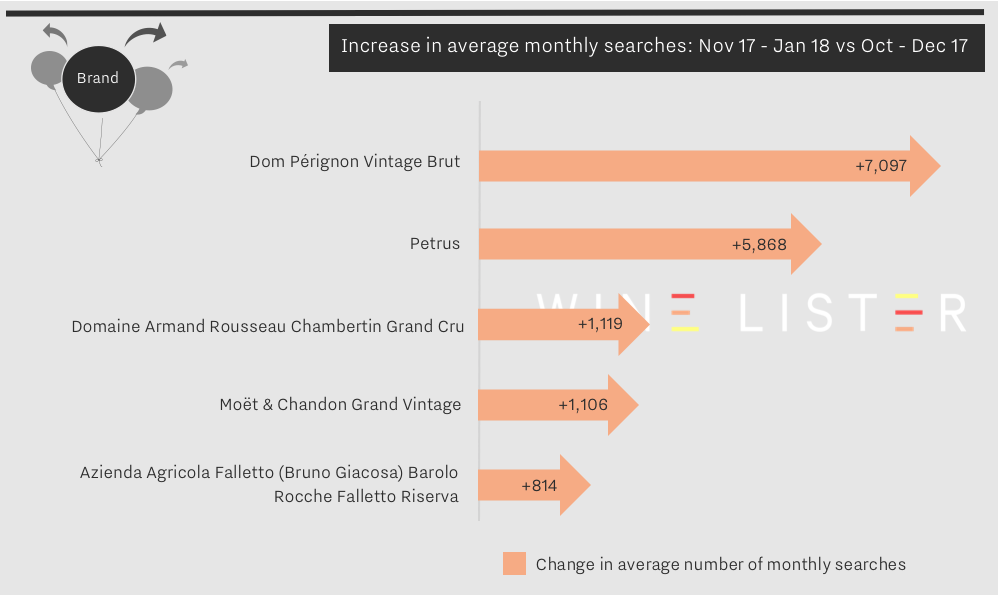
Dom Pérignon Vintage Brut is the largest gainer in popularity for the second time running. Increasing at a slower rate than in December, its popularity nonetheless grew by 7,097 searches into January, maintaining its 1000-point Brand score. Dom Pérignon remains the only wine to achieve a perfect score from any of the Wine Lister score categories. The other Champagne still riding high on searches is Moët & Chandon Grand Vintage, which increased by 6%.
Bordeaux creeps back onto the map for online searches at the beginning of 2018, with the first growths having featured heavily in searches up to December 2017. Petrus is in second place after Dom Pérignon, with an 8% increase in search frequency. It will be interesting to see if search increases for Bordeaux follow the same pattern as last year as we approach the 2017 en primeur campaign.
Armand Rousseau’s Chambertin appears in third place. Armand Rousseau was only one of two producers to achieve a perfect confidence rating from our Founding Members in our recent Burgundy study.
In fifth place for increased popularity is a bittersweet entry. Searches for Barolo Rocche Falletto Riserva from Azienda Agricola Falletto increased as the wine world learned of the sad passing in January of Piedmont legend, Bruno Giacosa. You can read more on Bruno Giacosa’s legacy in a recent blog on Barbaresco, here.
For wine lovers the world over, Burgundy is a region to be celebrated all year round. That being said, the modern interpretation of the traditional, post-harvest festival, La Paulée de New York, holds its West Coast counterpart this week, celebrating some of Burgundy’s finest producers in San Francisco’s best restaurants.
With Burgundy on the brain, we look back at our recent Burgundy study and the results of our Founding Members’ survey. Wine Lister asked 52 key members of the global wine trade across importers, merchants, and auction houses to rate their confidence in certain domaines from 0 to 10.
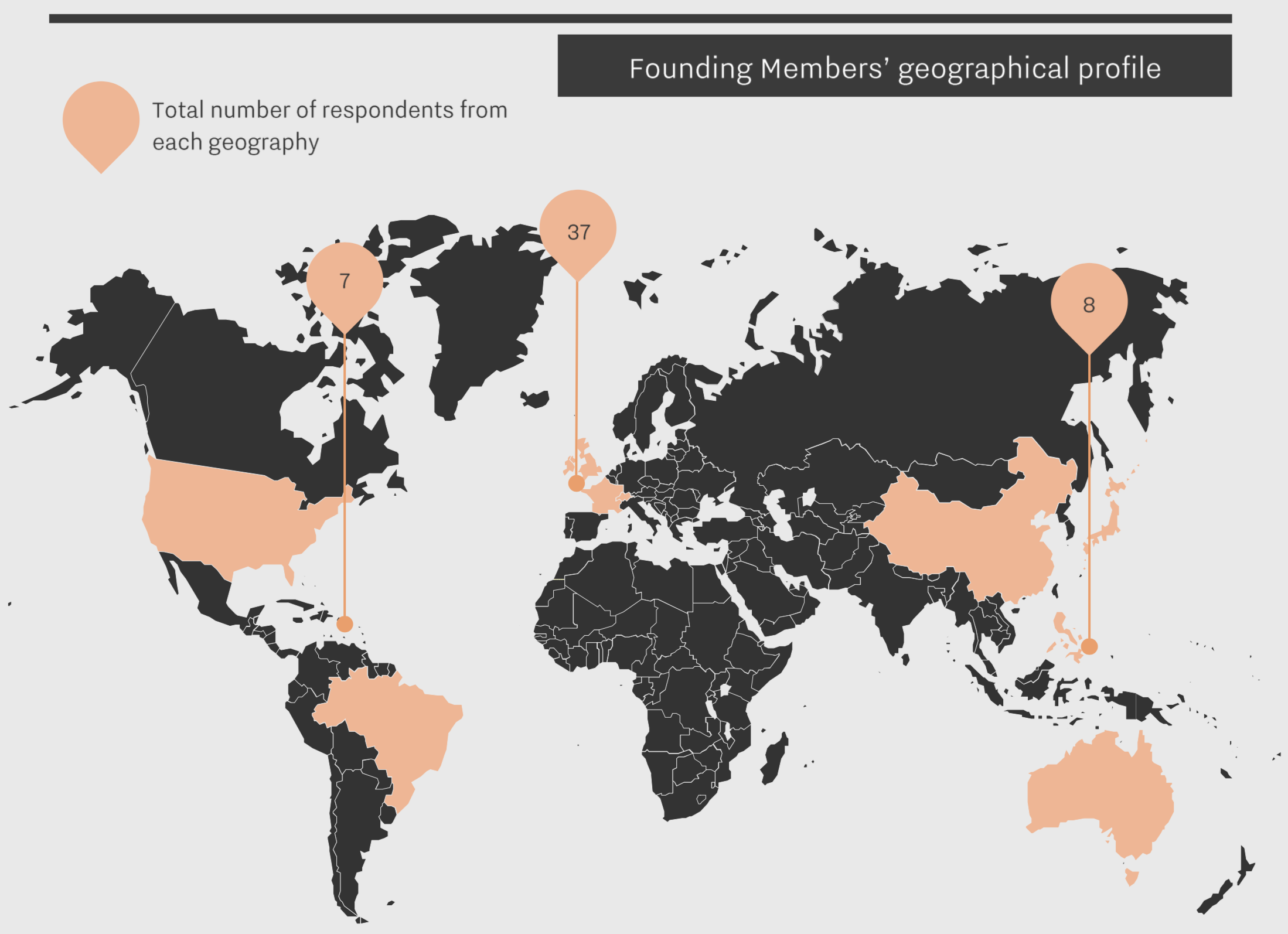
Our Burgundy study is the first to feature producers with a perfect confidence score. In Burgundy, two producers received a rating of 10/10. It perhaps comes as no surprise that Domaine de la Romanée-Conti (DRC) should be one of them. The other, Domaine Rousseau, is likely to have the strong performance of its Chambertin to thank for its perfect confidence score (Rousseau’s Chambertin holds the fifth best overall Wine Lister score in Burgundy, after four DRC wines).
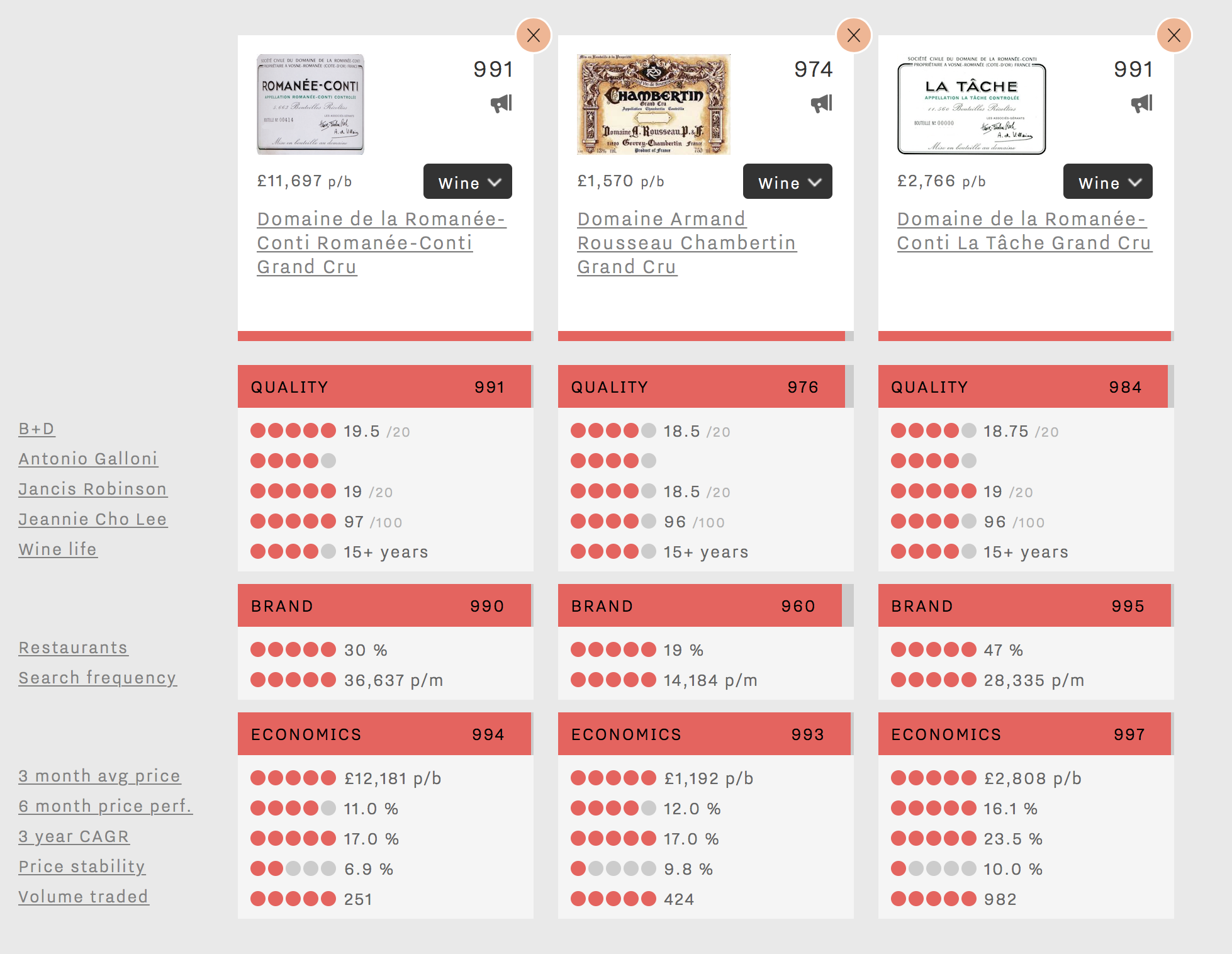
Six producers achieved a confidence rating of 9/10. D’Auvenay and Domaine Leroy’s marks confirm the trade’s outstanding level of confidence in Lalou Bize-Leroy. Whilst Mugnier and Roumier fly the flag for Burgundy’s top red producers, Coche-Dury and Raveneau show that the trade is sure about the prospects of the region’s most prestigious white wine producers.
26% of producers included in the survey gained a confidence rating of 8/10. Among them, Comtes Lafon, Ente, and Roulot confirm the prospects of Meursault and its top producers.
36% of producers received a score of 7/10 – still a strong result and underlining the trade’s high level of confidence in Burgundy. This confidence seems linked to the region’s consistent price performance, as one US fine wine auction house notes: “The single most interesting trend is pricing. Demand on the primary and secondary market is high, and it’s amazing to see that prices have not gone down at all…in years.”
For context, no Burgundy producer scored below 5/10, compared to 5% of Bordeaux wines in Wine Lister’s Bordeaux study last year.
For more detail on which Burgundy producers achieve top confidence ratings, see our full Burgundy study here, or subscribe to gain access.
For those joining the La Paulée festivities, we wish you a very happy Burgundy week!
We may have been glad to see the back of January, but it certainly wasn’t all blue. The first month of the year brought excitement to the wine world with Domaine de la Romanée-Conti’s (DRC) 2015 release, and to Wine Lister with our first ever 1000-point Brand score. For much of London’s bustling City, the end of February means one thing: bonus time. The Financial Times’ February edition of How To Spend It already features the iconic DRC – below are some further ideas for wines to blow the budget.
Prices from our data partner, Wine Owners, are shown ex duty and sales tax (VAT) per bottle as averages across Wine Lister featured vintages.
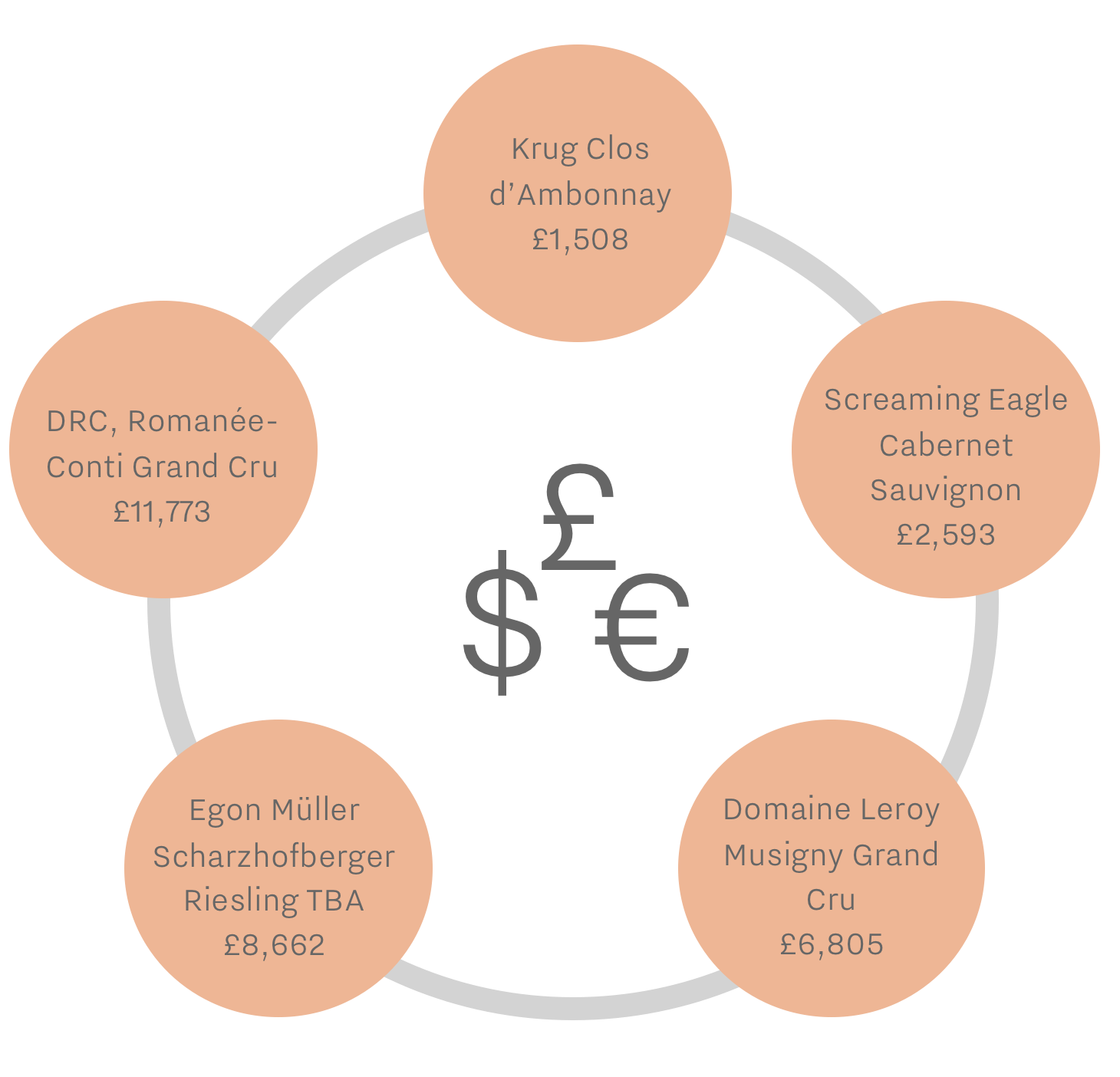
- Krug Clos d’Ambonnay
While Dom Pérignon or Louis Roederer’s Cristal are more commonly associated with City celebrations, those in the know will be toasting with Krug’s famous Pinot Noir expression. With an average Quality score of 969 and a price of £1,367 per bottle for the latest available vintage (2000), a glass of Krug Clos d’Ambonnay is, in itself, cause for celebration.
- Screaming Eagle Cabernet Sauvignon
If you’re one of the lucky few on Screaming Eagle’s direct mailing list, congratulations. It is one of the most talked-about wines by the trade based on the results of Wine Lister’s proprietary Founding Member survey, and counts over 17,000 monthly online searches on Wine-Searcher. The average £2,593 price tag per bottle is therefore a small price to pay, if indeed you are able to get your hands on one of the 7,800 bottles produced each year.
- Egon Müller Scharzhofberger Riesling TBA
Even harder to find is Egon Müller’s Scharzhofberger Riesling TBA. It breaks a number of records, including Wine Lister’s rarest wine (with an average of only 150 bottles produced per annum) and the highest ever average Wine Lister Quality score (995). Prices range from £5,848 per bottle to over £21,000 per bottle for older vintages.
- Domaine Leroy Musigny Grand Cru
The second most expensive of all French wines, let alone in Burgundy, is Domaine Leroy’s Musigny. At just over half the price of DRC Romanée-Conti, averaging £6,805 per bottle, its consistent quality is matched by impressive price growth, with a compound average growth rate of 26%. It featured in last year’s Listed blog, “the best wines money can buy”, which certainly still rings true.
Towards the lower end of the Domaine de la Romanée-Conti spectrum is its Corton. The 2015 vintage was released this morning at £275 per bottle. Below we look at all the facts:
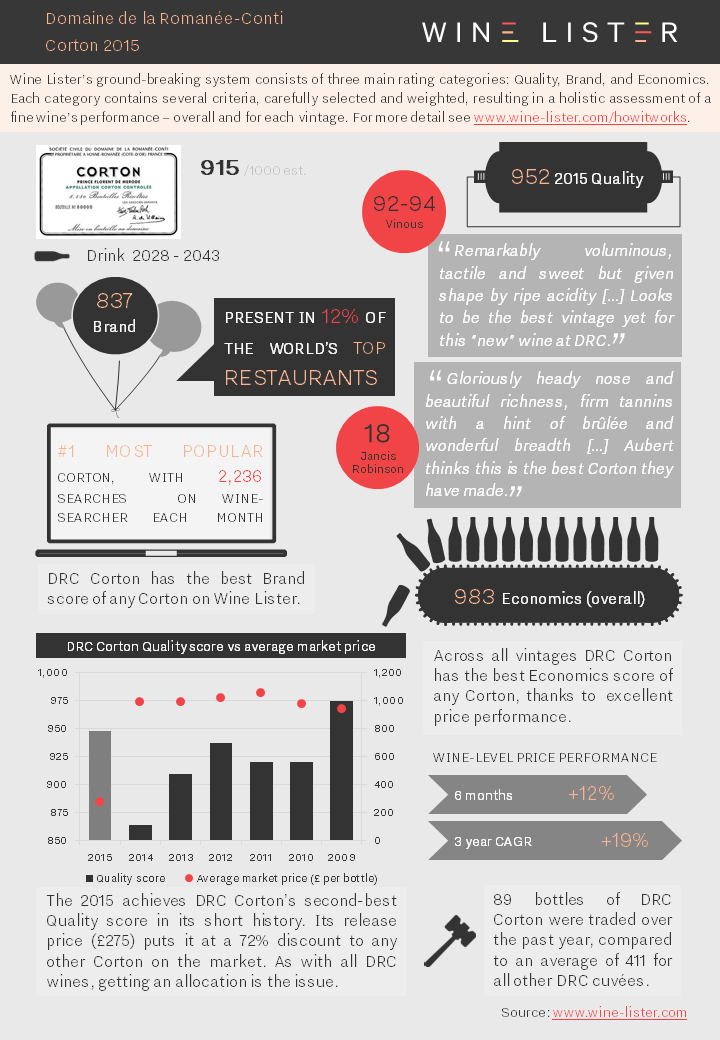
You can download the slide here: Wine Lister Fact Sheet DRC Corton 2015
Domaine de la Romanée-Conti has released its 2015 prices this morning. Below we summarise key points of its La Tâche 2015, UK RRP of £1000 per bottle.
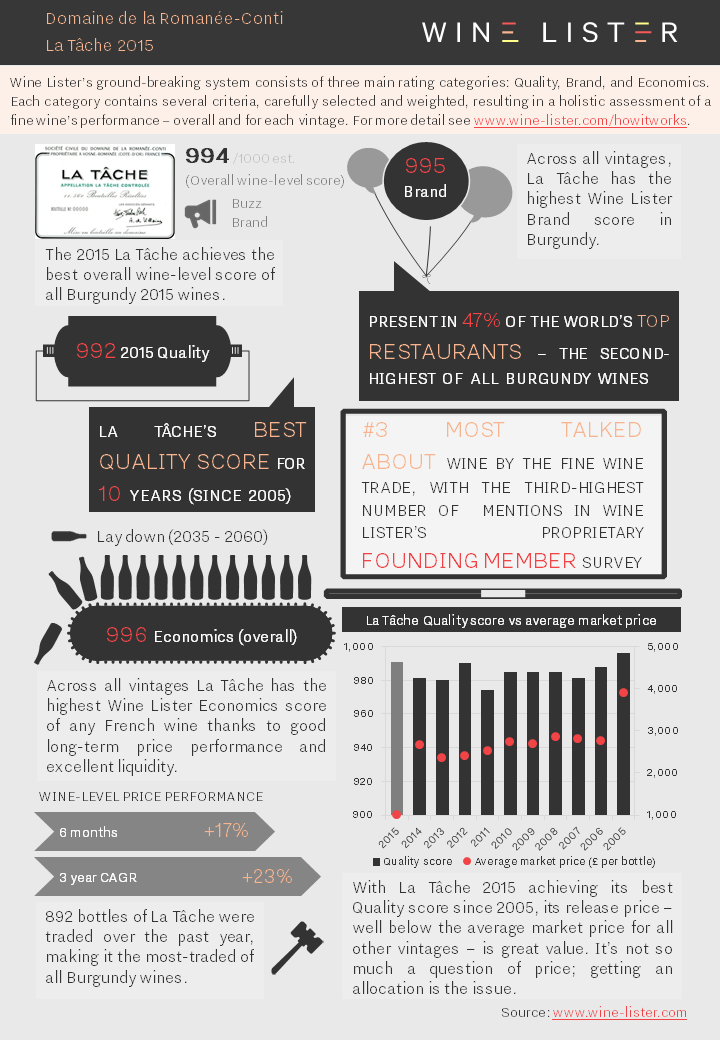
You can download this slide here: Wine Lister Fact Sheet DRC La Tache 2015
Our Burgundian blog series continues, bringing you new snippets from our recently published Burgundy market study. Included in the study are findings from a survey answered by Wine Lister’s Founding Members – 52 CEOs, MDs and department heads from companies representing over one third of global fine wine revenues.
The most-cited trend was one that we have already explored in our latest blog on Burgundy price performance, namely untrammelled price increases. However our panel of merchants, retailers and auction houses also identified trends such as new styles of winemaking, as well as pinpointing some of the region’s rising stars.
The new generation of Burgundian winemaker seems as committed to quality as ever, while maintaining a more open outlook than their predecessors. This often means a strong focus on terroir transparency and a light touch in the cellar.
According to the trade, many Burgundy winemakers of today seek lower extraction levels , less sulphur, and less oak influence, concentrating on purity of fruit, sometimes by means of whole bunch fermentation.
Buying trends on the consumer side match this freedom of expression, with merchants citing the lesser-known villages, such as Saint-Aubin and Fixin, as up and coming.
This being said, our Founding Members’ consensus on the new domaines to watch for quality and acclaim remained very much among Burgundy’s upper crust, with the likes of Comte Liger-Belair, Vougeraie and Roulot.
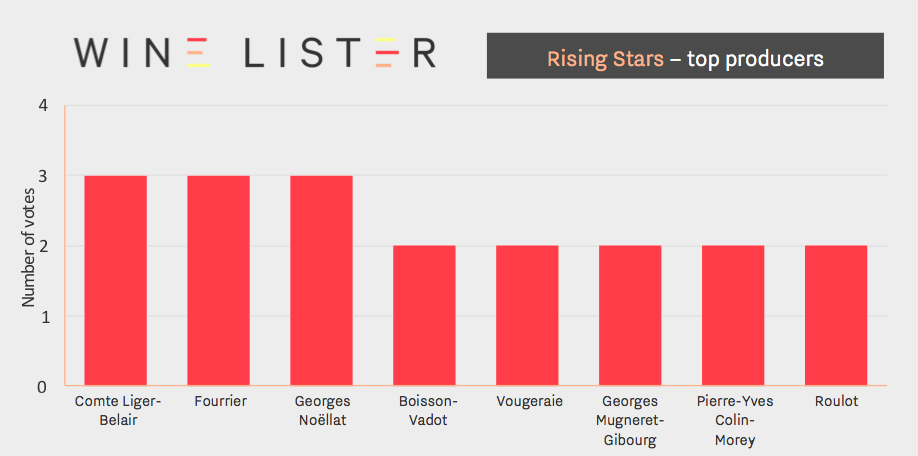
You can read about more trends in the full Burgundy market study by subscribing here. Alternatively, a preview of the first 15 pages is available here.
Our most recent market study is out, this time analysing 175 of Burgundy’s finest wines. Last week’s blog gave an overview of the study’s key findings. This week we take a deeper look into one of the upward trends, exploring some of Burgundy’s best price performers.
While it is impossible to argue the position of Domaine de la Romanée-Conti at the top of the Quality and Brand leaderboards, a greater mix of producers excel in long-term price performance. Lalou-Bize Leroy’s Domaine d’Auvenay is a frequent and expected feature within the top price performers, but the list is not without surprises.
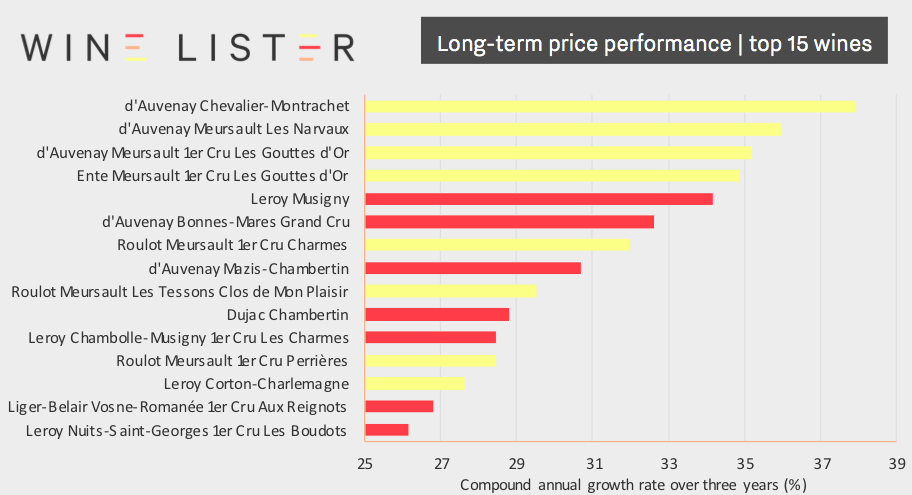
Arnaud Ente, while well known by those in the trade, is a quieter name in the global wine world. What Ente lacks in brand presence he makes up for in exceptional quality. Vines, notably his enviable Meursault plots, tend to be harvested late, giving wines their signature opulence. With a Quality score of 909 and a 3-year compound annual growth rate (CAGR) of 34%, Ente’s Meursault Les Gouttes d’Or is one of the best performing whites in Burgundy and the best 5-year price performer.
The Meursault village as a whole steals the show on price performance, accounting for 6 of the top 10 wines in the Economics score-criterion. Domaine Roulot, another producer flying slightly under the radar of Burgundy’s biggest brands also demonstrates strong long-term price performance across all three of their Meursault cuvées.
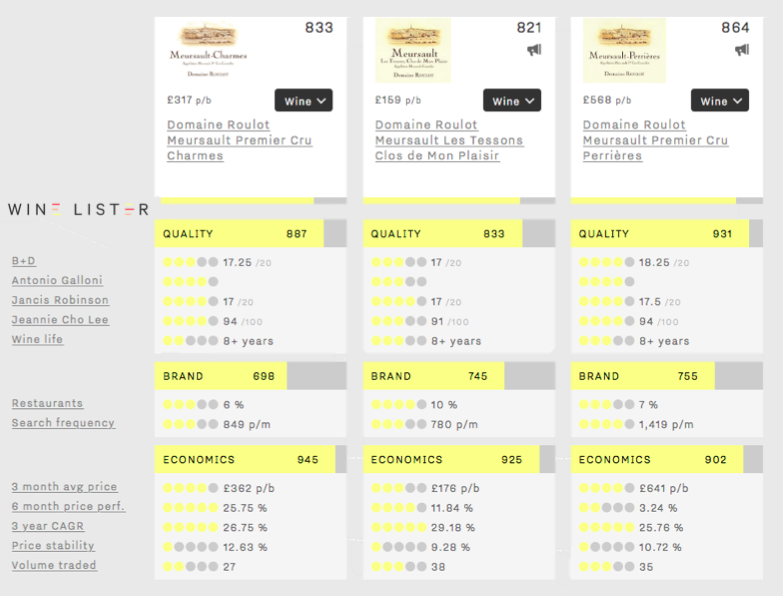
Meursault is not the only white village on the up. According to our Founding Members’ survey, which accompanies the Burgundy market study, the popularity of Saint-Aubin is increasing. Whether searching for the highest quality or the best value, it seems the white vineyards of Burgundy are the places to be this year.
You can read about more Burgundy trends in the full Burgundy market study by subscribing here. Alternatively, a preview of the first 15 pages is available here.



 From left to right: David Harvey, Arthur de Lencquesaing, Dan Jago, Charles Lea, Ella Lister, Jancis Robinson, Jan Konetzki, Adam Bruntlett, Katy Andersen, Grant Ashton, Sophie Mclean, Richard Harvey, Greg Sherwood, Aita Ighodaro, Joe Fattorini.
From left to right: David Harvey, Arthur de Lencquesaing, Dan Jago, Charles Lea, Ella Lister, Jancis Robinson, Jan Konetzki, Adam Bruntlett, Katy Andersen, Grant Ashton, Sophie Mclean, Richard Harvey, Greg Sherwood, Aita Ighodaro, Joe Fattorini.








